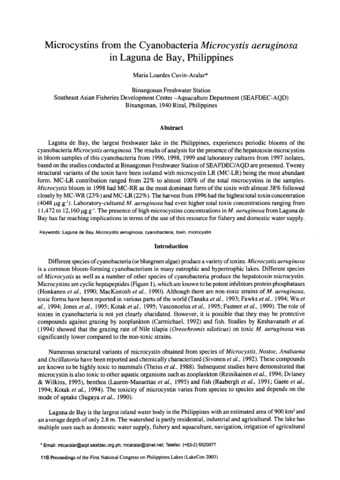Microcystins from the cyanobacteria Microcystis aeruginosa in Laguna de Bay, Philippines
- Global styles
- MLA
- Vancouver
- Elsevier - Harvard
- APA
- Help

View/
Date
2005Author
Page views
1,509ASFA keyword
AGROVOC keyword
Metadata
Show full item record
Share
Abstract
Laguna de Bay, the largest freshwater lake in the Philippines, experiences periodic blooms of the cyanobacteria Microcystis aeruginosa. The results of analysis for the presence of the hepatotoxin microcystins in bloom samples of this cyanobacteria from 1996, 1998, 1999 and laboratory cultures from 1997 isolates, based on the studies conducted at Binangonan Freshwater Station of SEAFDEC/AQD are presented. Twenty structural variants of the toxin have been isolated with microcystin LR (MC-LR) being the most abundant form. MC-LR contribution ranged from 22% to almost 100% of the total microcystins in the samples. Microcystis bloom in 1998 had MC-RR as the most dominant form of the toxin with almost 38% followed closely by MC-WR (23%) and MC-LR (22%). The harvest from 1996 had the highest total toxin concentration (4048 µg g-1). Laboratory-cultured M. aeruginosa had even higher total toxin concentrations ranging from 11,472 to 12,160 µg g-1. The presence of high microcystins concentrations in M. aeruginosa from Laguna de Bay has far reaching implications in terms of the use of this resource for fishery and domestic water supply.
Suggested Citation
Cuvin-Aralar, M. L. (2005). Microcystins from the cyanobacteria Microcystis aeruginosa in Laguna de Bay, Philippines. In M. L. Cuvin-Aralar, R. S. Punongbayan, A. Santos-Borja, L. V. Castillo, E. V. Manalili, & M. M. Mendoza (Eds.), Proceedings of the First National Congress on Philippine Lakes (pp. 116-122). Southeast Asian Regional Center for Graduate Study and Research in Agriculture (SEARCA).
Type
Conference paperISSN
1656-8099Collections
- Conference Proceedings [299]
- LakeCon2003 [49]

